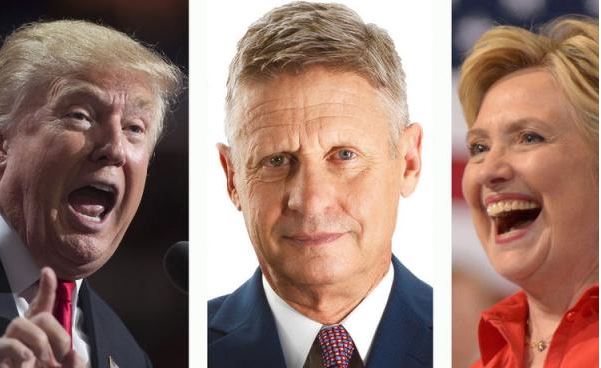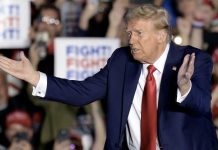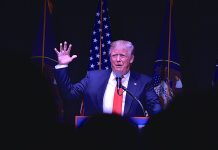WASHINGTON, Aug. 2 (UPI) — It is the issue consistently ranked as the most important by voters in poll after poll and while it rarely stirs passionate protest, voters make themselves clear every four years.
There is one thing Americans want most from their president: jobs.
In the 2016 election, the two major party candidates have vastly different approaches to how to create them.
Hillary Clinton does not address the issue of job creation in any single way. Rather, it is woven through her policy proposals on a number of issues.
The two most prominent: her desire to convert the nation into a clean energy leader and investing heavily to fix what she says is the nation’s crumbling transportation and utility infrastructure.
On energy, Clinton has proposed increasing federal investment to help install 500 million solar panels over her first term in office. Federal subsidies have created a booming solar power industry, but many of those subsidies could expire in the next few years, calling into question whether the fledgling industry can support itself without government assistance.
Clinton, who also views clean energy as crucial to her calls to halt climate change and global warming, supports federal subsidies to prop up emerging clean energy industries.
She has proposed creating a $60 billion fund to assist state and local governments in converting to renewable energy, money that would boost productivity and jobs across the energy sector.
At times, however, her comments on clean energy have also come at the expense of a jobs agenda. She once boasted during a CNN town hall that her clean energy plan would put coal mines “out of business” — a comment widely regarded in Appalachian coal country as a threat to their most significant job-creating industry.
On Monday, she released a “first 100 days jobs plan” that includes mention of clean energy and infrastructure improvements.
Clinton has proposed government investment to create jobs in infrastructure spending, which she said will represent the most significant federal investment in infrastructure spending since the Eisenhower administration built the nation’s highway system.
She has proposed a $275 billion plan to invest in fixing the nation’s infrastructure, something she says will have the twin positive effects of repairing crumbling roads, bridges, water and sewer pipes, while creating hundreds of thousands of middle class construction jobs.
Clinton’s plan cites a statistic by the White House Council of Economic Advisers, which states that for every $1 billion in public investment in infrastructure spending, 13,000 jobs are created. Given that estimate, and the fact her plan calls for the immediate spending of $250 billion on infrastructure projects, the plan could create up to 3.25 million jobs.
She has also called for enforcing existing trade agreements to crack down on abuses from other countries that harm U.S. manufacturers and rejecting the Trans-Pacific Partnership on the grounds it “[does] not put U.S. job creation first.”
“The vast majority of the jobs created by infrastructure investment are good-paying, middle-class jobs — paying above the national median,” her campaign says. “And beyond creating good-paying jobs today, infrastructure investments promise to enhance the productivity of the American economy tomorrow — helping to boost the incomes of working Americans in the future.”
Donald Trump has put forth two proposals he said would reshape the U.S. economy and unleash millions of jobs for U.S. workers.
The first is his promise to renegotiate free trade deals with China and other countries he says have led to the mass exodus of manufacturing jobs over the past 25 years.
The second is a significant reordering of the tax code and sharp reductions in both personal income taxes and the corporate tax, which he says will spur business growth, increase personal wealth and, in turn, create more jobs.
Trump says America has seen more than 50,000 factories close since China was admitted to the World Trade Organization under former President Bill Clinton, who hailed it at the time as progress in opening Chinese consumer markets to U.S. businesses.
Trump said the Chinese have manipulated their currency to undervalue their own exports, while maintaining protectionist policies that keep out foreign goods, creating a trade imbalance and forcing U.S. companies to ship jobs overseas to compete.
Trump proposes reopening trade agreements and, if necessary, implementing the United States’ own tariffs on Chinese imports to level the playing field.
That, combined with a drastically overhauled tax code, would bring businesses back to the United States and revive the struggling manufacturing sector, creating millions of jobs that have been lost over the decades.
“If you give American workers a level playing field, they will win. … The results will be huge for American businesses and workers. Jobs and factories will stop moving offshore and instead stay here at home. The economy will boom,” Trump’s trade plan states.
The second part to Trump’s plan is to drastically overhaul the tax code, to create what he says will be a simpler filing method for individuals and businesses.
The plan would drastically reduce the amount of taxes individuals and businesses would pay.
Trump would reduce the corporate tax rate from its present 35 percent to 15 percent, while also eliminating the hundreds of tax break loopholes that have been implemented over the years to the advantage of specific sectors of the economy.
Trump says the tax reduction, combined with a one-time repatriation of corporate cash being held overseas, which could be brought back to the United States at a discounted 10 percent tax rate, would reduce burdens on businesses, create more business development and increase overall employment.
“Too many companies — from great American brands to innovative startups — are leaving America, either directly or through corporate inversions,” Trump’s plan states. “Politicians in Washington have let America fall from the best corporate tax rate in the industrialized world in the 1980s (thanks to Ronald Reagan) to the worst rate in the industrialized world. That is unacceptable. Under the Trump plan, America will compete with the world and win by cutting the corporate tax rate to 15 percent, taking our rate from one of the worst to one of the best.”
Libertarian Johnson: ‘I didn’t create a single job’
Libertarian Party candidate Gary Johnson, the former Republican governor of New Mexico, boasts on his campaign website, “as governor, I didn’t create a single job.”
The counterintuitive statement is a nod to the Libertarian philosophy that government can only create jobs for itself, but the unfettered private sector will drive the economy.
“Government’s role is to create and maintain a regulatory and tax environment in which private job-creators can prosper,” Johnson’s plan states.
The Libertarian platform calls for an end to all government regulation except those meant to protect the public from bad actors who would endanger public health, safety or individual property.
“Regulation should not be used to manipulate behavior, manage private lives and businesses, and to place unnecessary burdens on those who make our economy work.”
His plan includes eliminating all income taxes on businesses and abolishing the IRS, instead creating a one-size-fits-all consumption tax that would fund the federal government.






